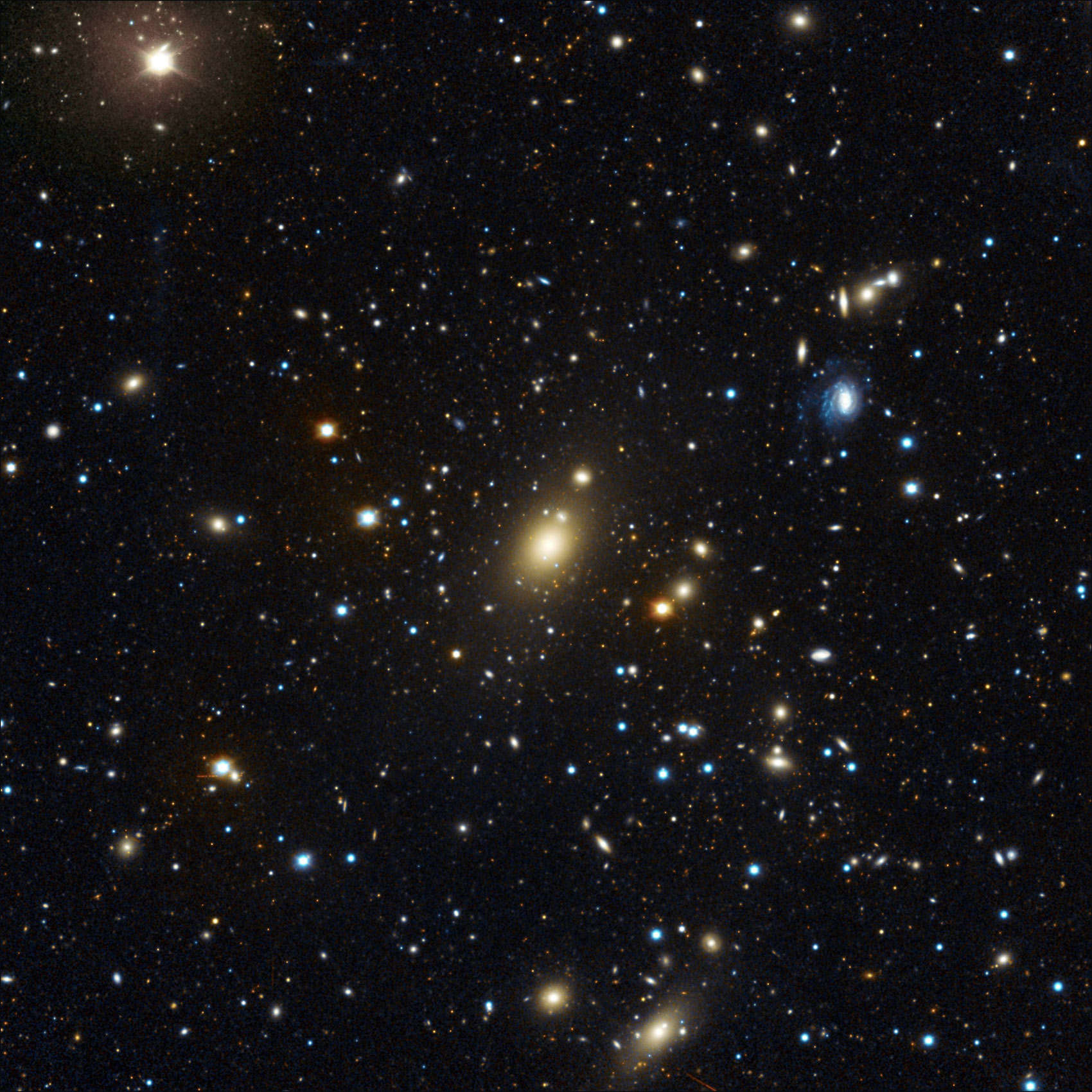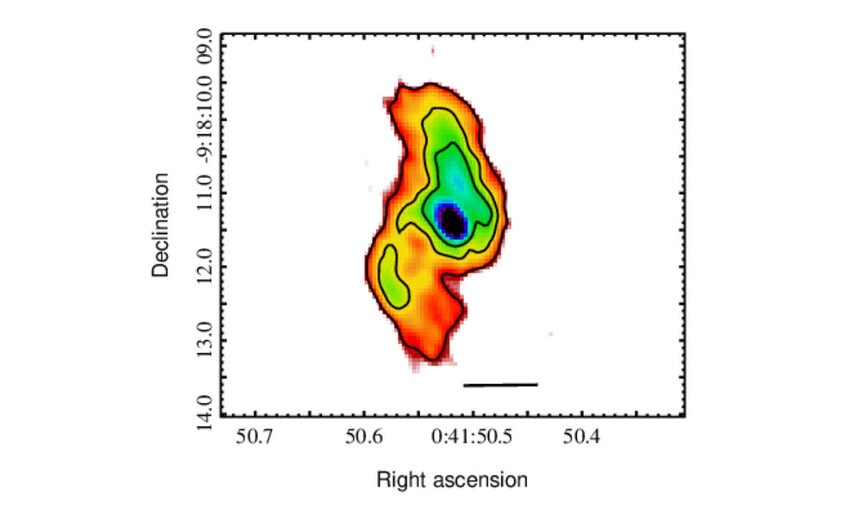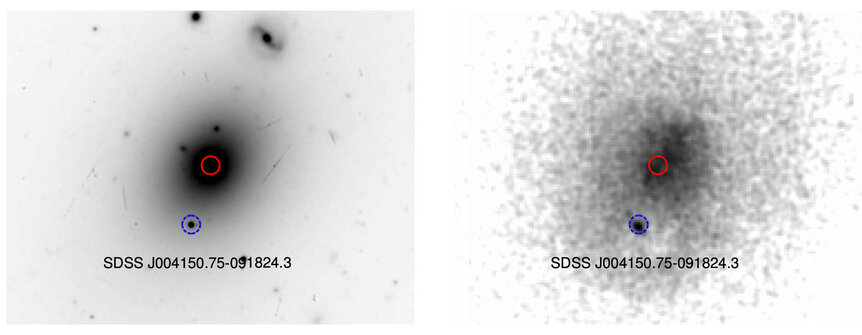Create a free profile to get unlimited access to exclusive videos, sweepstakes, and more!
So how many supermassive black holes *are* there in Holmberg 15A anyway?

Around 760 million light years from Earth lies the galaxy cluster Abell 85, a mighty collection of about 500 galaxies all orbiting one another. At its center is the enormous elliptical galaxy Holmberg 15A… and I do mean enormous; some estimates put it at well over 50 trillion times the mass of the Sun, dozens of times more massive than the Milky Way.
All big galaxies have a supermassive black hole in their hearts, millions or billions of times the Sun's mass. In very rough terms the black hole size scales with the galaxy, and since the galaxy is so huge it's thought the black hole at its core may be as well. It's never been measured directly, but using various indirect bellwethers its mass has been estimated at tens of billions to well over a hundred billion times the Sun's mass. If true, it's the most massive black hole known. However, its actual size is in fact unknown.
But there's more of a mystery here as well. Some astronomers have speculated that it's not one black hole but actually two, a supermassive black hole binary system. These are very rare, forming when two big galaxies collide and merge. Eventually the two big bruisers approach one another and enter into mutual orbit. Over many billions of years they can coalesce, merging themselves to form a single, more massive black hole.
Not many binary systems like this are known, despite dedicated searches for them. While it's not always possible to see them directly, their effects on the galaxy around them can give away their presence.
For example, stars in the center of the galaxy will orbit both black holes. From far away the gravitational fields of both black holes combine and it's like orbiting a single object. But if a star gets close, the difference in distance between the star and the two individual black holes can affect the star's orbit. As it swings past, the orbital motion of the two black holes around each other can fling the star away hard enough that it no longer stays in the center of the galaxy. Over time, the central part of the galaxy will have a deficit of stars.
So, one way to look for binary supermassive black holes is to look at the very centers of these galaxies and see if they are dimmer there than expected. If so, this may be due to the black holes ejecting stars.
And hey, observations of Holmberg 15A described in a paper published in 2014 show that the center of the galaxy is dimmer than expected. That's interesting! So is this evidence of a binary black hole?
Well, hold up. A new paper published late 2020 refutes that claim. The problem, it's claimed, is in the air around us.
The atmosphere above our heads is constantly moving around. As light from an object in space passes through it, little packets of air act like lenses, bending the light to and fro. What we see from the ground is the object apparently dancing around a bit — this is what causes a star to twinkle. But if you take a long exposure of that object it gets blurred out, just like taking a long exposure with a handheld camera will blur the photo due to your hand moving a bit.
What the second paper argues is that this phenomenon adversely affected the measurements of Holmberg 15A's core. The light from the center got smeared out, making it look dimmer than expected. Sure enough, observations taken under better conditions show that the center is not dimmer than expected, and, if anything, is actually a little brighter than you'd expect.
Also, deep, high-resolution radio observations of Holmberg 15A using the Very Large Array don't show any evidence of a black hole pair there. It does reveal relatively short (7,000 light years long each) jets of matter streaming away from the core, which is pretty good evidence there's a black hole there. But it looks to be alone.
That seems to put the kibosh on the binary black hole. But wait! There's more!
Right next to the core of the galaxy is a bright source of light, seen in images taken with optical telescopes. An image using the Chandra X-ray Observatory shows this object as well. As matter falls into a black hole it can emit X-rays strongly.
Could this be another black hole? The 2014 paper suggests it could be. It's a relatively minor point they make, and they note previous observations seem to indicate it's a background galaxy, but they basically suggest it's not totally clear and that follow-up observations should be made to make the case one way or another. Fair enough.
In the 2020 paper, though, results of such follow-ups were reported. Using the monster 10-meter Gran Telescopio Canarias, a spectrum of this object reveals it's a quasar, a galaxy with its central black hole gobbling down matter and emitting light, including X-rays. However, this quasar is a staggering 9.5 billion light years away, far far in the background, and its alignment with the center of Holmberg 15A coincidental.
Ah well. The brief hopes that this was a triple black hole are dashed, and it's unlikely even to be binary. To be clear, the second paper can't rule out a binary, either, just that the evidence so far doesn't support that conclusion. Perhaps extremely high-resolution radio observations can clear this up, but those haven't yet been done.
So is it even an ultramassive black hole? Can it at least keep that title?
That's hard to say. There are copious papers looking at the mass, and they all get pretty high numbers for it, so it does seem likely to me there's a beast in the middle of that galaxy, but just how beastly it is hasn't yet been determined.
I know I'm not really giving you a lot of hard answers here, but hey, that's astronomy. It's not like in the movies when you point a telescope at something and yell, "AHA!" Sometimes it can be like that, but not often. Usually it's incremental, finding something interesting, then following up on it, usually many times, working ever-closer (you hope) toward figuring out what the heck it is you're seeing. But the Universe can be jealous of its secrets, and our own instruments and how we use them can make this harder.
If it were easy we'd already know everything. And that wouldn't be nearly as much fun.
My thanks to the author of the new research, Juan Madrid, for letting me know about this.





























